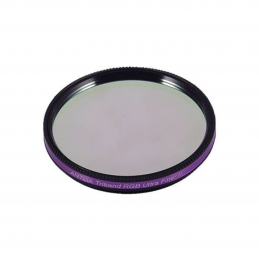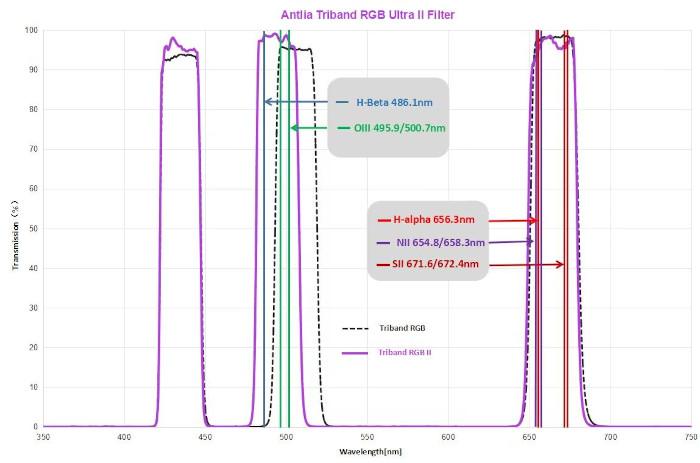
Reference: ZWEAF-N
Brand: ZWO
Reference: ZWEAF-N
Brand: ZWO
Reference: POA-URANUS-C
Brand: Player One
Reference: POA-ACS
Brand: Player One
Reference: AS-FRA400
Brand: ASKAR - Sharpstar
Reference: ZWASI120MINI
Brand: ZWO
Reference: AS-SET-DUO-D1D2
Brand: ASKAR - Sharpstar
Reference: ZWDC-Y-SPLIT
Brand: ZWO
Reference: AS-F-DUO-SO-D2
Brand: ASKAR - Sharpstar
Banner




 security
security
100% Secure Payment
 Delivery policy
Delivery policy
Express shipping of in-stock parts
 RETURN POLICY
RETURN POLICY
Express shipping of in-stock parts
The Antlia RGB Ultra II Triple Band filter is designed to remove a good portion of light pollution for "one-shoot color" (OSC) cameras such as color astronomy cameras or digital cameras as well as monochrome cameras. Antlia offers instead of 3 distinct RGB filters: a single filter crossing these 3 spectral domains. The blue has a wide band of 20nm, the green of 25nm allowing the passage of the OIII lines (at 495.9 and 500.7nm) and the red of approximately 30nm (with the passage of the NII, H-Alpha and SII lines) .

It is therefore more selective than classic RGB filters which do not cut light pollution... while being more "bright" than H-Alpha, SII, OIII type interference filters. It is therefore compatible with the imaging of galaxies and clusters (which radiate throughout the visible spectrum). Antlia estimates that 90% of objects are photographable in a sky between 1 and 8 on the Bortle scale... with a balanced and particularly well-crafted color balance. Another important aspect of this particular filter is a clear "cut-off" of each zone and compatibility with instruments with an ultra-short focal ratio up to f/2.

This version II offers 2 important improvements. The first is a higher transmission rate in the 3 spectral zones (except a slight loss in SII), an appreciable plus for the search for maximum brightness/contrast. The second is a shift in the central spectral band. The H-Beta and OIII lines are better covered as shown in the curve below.
No customer reviews for the moment.
Reference: 8H11I8
Brand: Astronomik
Reference: 8H00IC
Brand: Astronomik
Reference: L-PRO-EOS-CLIP
Brand: Optolong
Reference: BA-2961175
Brand: Baader Planetarium
Reference: 8H00IN
Brand: Astronomik
Reference: ANHA3-125
Brand: ANTLIA
Reference: 8H00F3-10212550
Brand: Astronomik
Reference: 8H11HO
Brand: Astronomik
Reference: 43797
Brand: Astronomik
Reference: ANHA4.5-125
Brand: ANTLIA
Reference: ANOIII3-125
Brand: ANTLIA
Reference: L-ENHANCE-EOS-CLIP
Brand: Optolong
Reference: POA-AH-UVIR-CUT-2
Brand: Player One
Reference: 8H11HE
Brand: Astronomik
Reference: POA-ERF125
Brand: Player One
Reference: 8H00OZ
Brand: Astronomik

check_circle
check_circle